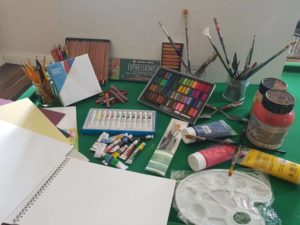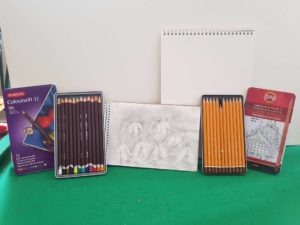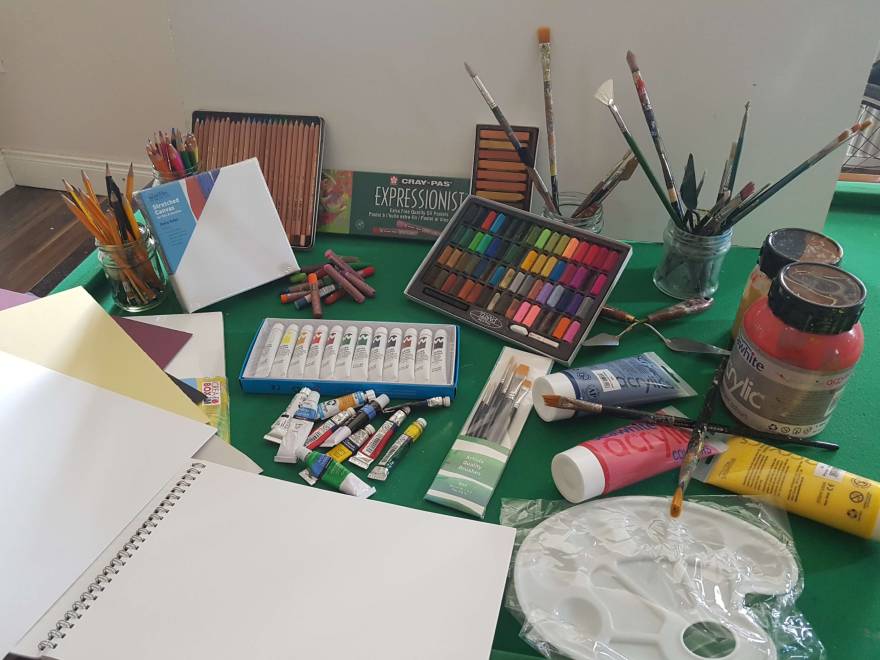Art Class Course – Art for Beginners

Art for Beginners, choosing an art class course – learning about art may seem daunting at first. Maybe you are looking at the picture below and feeling baffled with the array of brushes, ,paper, pads etc. It is like a minefield. Where do I start? Do I need to learn to draw first or can I just dive into painting. But what type of paints do I use. I can see there are watercolours, oils, acrylics even gouache to choose from. But which one do you start with? What equipment do I buy? Do I paint on paper or canvas or board or what?
The Art world is an exciting place full of many options to discover and create. So a good way to start is to try everything and you will soon find out what you are drawn to. It is not only about the way it looks, it is also about how it moves when you apply it. It is about does it feel comfortable in your hands. And even how it smells to you. In our Seasons Art Class course, students get to try out a variety of mediums eg drawing, pastels (oil and/of soft), watercolours and/or gouache and acrylics. It is a good broad range of media to try in any art class course. It will help you to determine what is your favourite medium.
To the learn the basics of your art, it is important to find the right tools for you. Again you can experiment but there are some which are better than others. I will go through suggestions as to what equipment to use for different media.

Drawing
A good set of H to 8B pencils eg Faber Castell or Hoh Noor. The harder pencils such as HB are used for outlines. The softer pencils ie B upwards are good for shading. These ranges of pencils will give you a good range of light and dark tones. Don’t forget an eraser, sharpener and ruler. Derwent and Faber Castell have a good range of different colouring pencils as well.
Student paper or even a sketch pad are good to use when starting your art class course. I like having a sketch pad as you can look back on your progress. A3 size is useful for larger drawings. We use this size when teaching perspective to our students in our Drawing module. If you need smaller size, A3 can be halved to A4 size
Painting
I would start with acrylics. They dry faster than oils and also very versatile. You can paint over and start again if you make a mistake, There are lots of techniques you can learn with acrylics as you can apply it thin like a wash or as a glaze or apply it thickly with a palette knife called the impasto effect. Other paint types are watercolours, gouache, inks, oils, oil pastels and soft pastels. When buying these paints you don’t need to buy artist quality (can be very expensive), buy good quality student paints. I will cover these in more detail in other blogs. Check out Starting with Acrylics
Paint Brushes
Synthetic brushes are good to start with for both watercolours, acrylics, gouache and oils. You can purchase different brush types, eg flat, round, fan, filbert and many more. I suggest that you start with a range of flat and round brushes of different sizes. You can buy these in sets as well. Once you have had more experience with painting, then you can buy them individually. One brand that I liked when starting out were Richard Oliver *. I also would keep my watercolour brushes seperate from acrylic brushes etc as acrylic paint can harden the brushes if not cleaned probably. So I make a rule, keep these brushes seperate.
Paper or Canvas or Board
I would suggest that you start with using paper if you can. As you are going to practising techniques , it is easier to dispose or store paper than canvas/boards.
In the case of watercolour, you will need to use good quality watercolour paper of at least 300 gsm. I have seen alot of cheap watercolour paper sold in local stationery shops which are poor. It will just destroy your experience with learning watercolours.
Pastels(oil and chalk) should be used on pastel paper as well. I have used 160 gsm pastel paper for this.
Acrylics and Oils can be painted on anything really ie paper, canvas, boards, wood, glass. However at first, stick to paper for practising. Paper also can be framed. In our course we actually have shown our students how to create different colour mounts for their paintings before framing them.
Mixed Media
You can also experiment with mixing medias. Try collage where you add almost anything to artwork eg shells, stones, pieces of materials. This is where you can really test your creative side. During our courses we have introduced students to collage and they have been amazed at how much they enjoy them. Try mixed media, pencils, pens, inks, charcoal, washes and impasto. You might get some crazy results but it all helps you immerse yourself and sparks new ideas.
I hope this gets you started into the adventurous world of colour and creativity.


